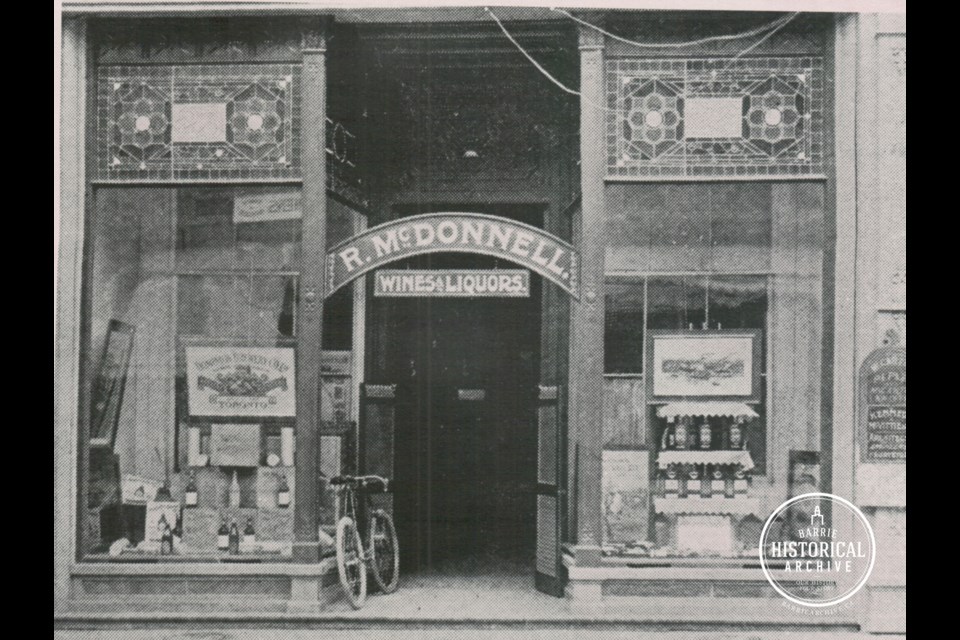This ongoing series from Barrie Historical Archive curator Deb Exel shows old photos from the collection and one from the present day.
R. McDonnell Wines & Liquors
This week, the Barrie Historical Archive is celebrating its fourth anniversary with a new virtual walking tour of downtown Barrie’s ‘grand’ hotels. The stops on our virtual ‘pub crawl’ include the Royal Hotel, the Vespra House Hotel, Clarkson House Hotel, Queen’s Hotel, Wellington Hotel, American Hotel, Victoria Hotel and Simcoe Hotel. Visit our Facebook page to see our daily guides!
In keeping with the theme of our tour, we’re going to talk spirits and a brief history of drinking in Ontario.
Thomas O’Meara managed R. McDonnell’s Wines and Liquors at 23 Dunlop St. E. It opened in 1889 and was thought to be an attractive building and the best local shop for fine liquors.
The store had a steadily growing base of customers, due to McDonnell’s business approach and good service. McDonnell’s carried all the leading brands of domestic and imported wines and liquors for both retail and wholesale markets.
Less than 30 years later, the Ontario Temperance Act of 1916 spelled the arrival of Prohibition. By 1918, the Canadian government had outlawed the import, manufacture or transportation of alcohol. In fact, both the Wellington and Simcoe hotels were closed on Sept. 18, 1916, as the Act went into effect.
Interestingly — or maybe luckily — in Ontario, doctors and drug stores could write prescriptions for alcohol. In 1920 alone, 650,000 ‘scripts were written!
The Liquor Control Act of 1927 ended Prohibition and introduced the Liquor Control Board of Ontario (LCBO) to "control the sale, transportation and delivery" of alcoholic beverages in Ontario, while the Brewers Retail similarly controlled the sale of beer.
Possibly the very first LCBO in Barrie was located in the American Hotel.
Many of the hotels on our tour would have been impacted by a 1934 mandate, which gave the LCBO oversight of by-the-glass sales of alcohol in drinking establishments. These regulations also gave the LCBO the right to restrict the number of patrons allowed to sit together, limitations on singing and, most notably, the segregation of women from single men.
Most hotels back in the day had a ‘Ladies and Escorts’ side and a men’s entrance to separate the drinking crowds.
From 1927 until 1962, if you wanted to shop at the LCBO, you had to have a permit. The annual permit booklets, eventually a card, were presented when purchasing liquor and the clerk would record exactly what and how much was being bought. This tracking of the quantity and frequency of purchases allowed the LCBO all manner of ‘big brothering’ in an effort to control who and how much an individual could ‘drink’.
Some readers may even remember a time when they had to complete a little slip of paper at a desk before handing it to a clerk to retrieve their alcohol, bag it under the counter, then discreetly slide the package across the countertop to them.
It wasn’t until 1969, when the first self-serve store was introduced, that the whole customer experience for LCBO shoppers started to change.
But back in the late-1800s, liquor stores were much different. Unfortunately for Mr. McDonnell, he was only able to have the satisfaction of owning a successful business for four years, before he passed away.
His wife, Mrs. McDonnell, took over operation of the store, and with the continuing management of Mr. O’Meara, it remained a popular and thriving main street shop.



